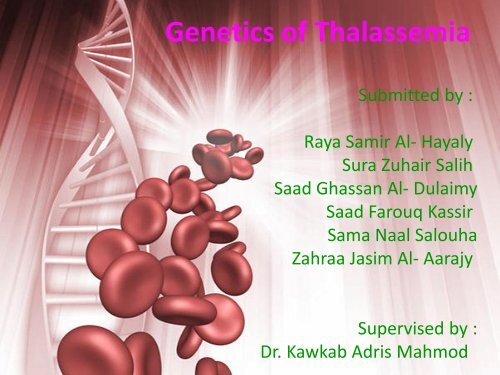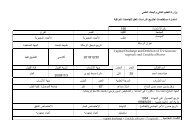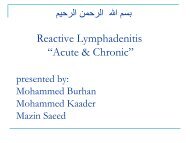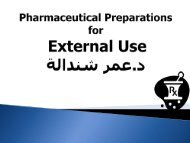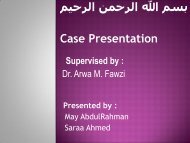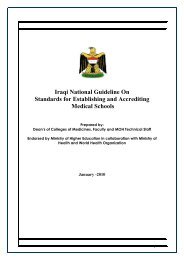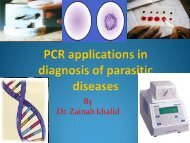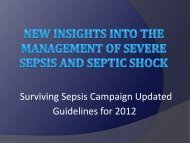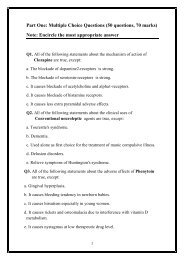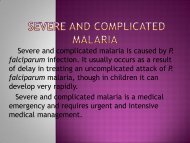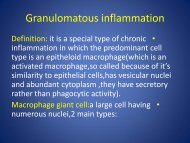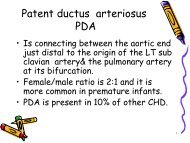Beta Thalassemia
Beta Thalassemia
Beta Thalassemia
You also want an ePaper? Increase the reach of your titles
YUMPU automatically turns print PDFs into web optimized ePapers that Google loves.
Genetics of <strong>Thalassemia</strong><br />
Submitted by :<br />
Raya Samir Al- Hayaly<br />
Sura Zuhair Salih<br />
Saad Ghassan Al- Dulaimy<br />
Saad Farouq Kassir<br />
Sama Naal Salouha<br />
Zahraa Jasim Al- Aarajy<br />
Supervised by :<br />
Dr. Kawkab Adris Mahmod
Raya Samir Al- Hayaly<br />
• Definition of <strong>Thalassemia</strong><br />
• Molecular Genetics
<strong>Thalassemia</strong> :<br />
oFirst recognized in 1952 by Dr. Thomas B. Cooley .<br />
oThe name thalassemia is a Greek term derived from thalassa meaning The sea ,<br />
plus Emia pertaining to blood .<br />
o <strong>Thalassemia</strong> is called Erythroblastosis , Mediterranean anemia or Cooley s anemia<br />
oApproximately 100,000 babies worldwide are born with severe forms of<br />
thalassemia each year , However the condition occurs more frequently in people of<br />
Italian, Greek, Middle Eastern including ( Iraq ) , Southern Asian and African ancestry<br />
.
<strong>Thalassemia</strong> :<br />
Is a group of inherited blood diseases that affect a person's ability<br />
to produce hemoglobin in red blood cells . A person with thalassemia<br />
does not have enough hemoglobin or red blood cells, which can cause<br />
mild to severe anemia .<br />
Hemoglobin : is a protein found in red blood cells . It carries oxygen to<br />
all parts of the body .<br />
Normal hemoglobin( also called hemoglobin A) has 4 protein chains,<br />
two alpha globin chains and two beta globin chains, and iron<br />
containing chemical group called heme .
Molecular Genetics :<br />
The genes that code for the globin chains of hemoglobin are found on<br />
chromosome 11 and 16 .<br />
Each person has ( 4 alpha globin genes located on chromosome 16 ) that code for<br />
alpha globin chains of hemoglobin( two from each parent ) and each person has<br />
( 2 beta globin genes located on chromosome 11) controlling the production of beta<br />
globin chains of hemoglobin( one from each parent ) .<br />
This keeps the production of protein chains equal . <strong>Thalassemia</strong> occurs when a globin<br />
genes fails( mutation occurs) and the production of globin protein chains is thrown<br />
out of balance .
The genes that code for the globin chains of hemoglobin<br />
are found on chromosome 11 and 16 .
Sura Zuhair Salih<br />
• Types of <strong>Thalassemia</strong><br />
• Alpha <strong>Thalassemia</strong>
Types of <strong>Thalassemia</strong><br />
α –thalassaemia affect α-chain synthesis<br />
β –thalassaemia affect β -chain synthesis
Alpha <strong>Thalassemia</strong><br />
• mutation of 1 or more of the 4 alpha globin<br />
genes on chromosome 16<br />
• severity of disease depends on number of<br />
genes affected<br />
• results in an excess of beta globins
Classification of Alpha <strong>Thalassemia</strong> :<br />
1- Silent Carriers<br />
• 3 functional alpha globin genes<br />
• No symptoms, but thalassemia could<br />
potentially appear in offspring
2- Alpha <strong>Thalassemia</strong> Trait<br />
• 2 functional globin genes<br />
• results in smaller blood cells that are lighter in<br />
colour<br />
• no serious symptoms, except slight anemia
3- Hemoglobin H Disease<br />
• 1 functional globin gene<br />
• results in very lightly coloured red blood cells<br />
and possible severe anemia<br />
• hemoglobin H is susceptible to oxidation,<br />
therefore oxidant drugs and foods are avoided<br />
• treated with folate to aid blood cell<br />
production
4- Alpha <strong>Thalassemia</strong> Major or<br />
( Hydrops Fetalis )<br />
• no functional globin genes<br />
• death before birth (embryonic lethality)
Saad Ghassan Al- Dulaimy<br />
• <strong>Beta</strong> <strong>Thalassemia</strong>
<strong>Beta</strong> <strong>Thalassemia</strong><br />
• mutations on chromosome 11<br />
• hundreds of mutations possible in the beta<br />
globin gene, therefore beta thalassemia is<br />
more diverse<br />
• results in excess of alpha globins
Classification of <strong>Beta</strong> <strong>Thalassemia</strong> :<br />
1- <strong>Beta</strong> <strong>Thalassemia</strong> Trait ( Minor )<br />
• slight lack of beta globin<br />
• smaller red blood cells that are lighter in<br />
colour due to lack of hemoglobin<br />
• no major symptoms except slight anemia
2- <strong>Beta</strong> <strong>Thalassemia</strong> Intermedia<br />
• lack of beta globin is more significant<br />
• bony deformities due to bone marrow trying to make<br />
more blood cells to replace defective ones<br />
• causes late development, exercise intolerance, and<br />
high levels of iron in blood due to reabsorption in the<br />
GI tract<br />
• if unable to maintain hemoglobin levels between 6<br />
gm/dl – 7 gm/dl, transfusion or splenectomy is<br />
recommended
3- <strong>Beta</strong> <strong>Thalassemia</strong> Major<br />
• complete absence of beta globin<br />
• enlarged spleen, lightly coloured blood cells<br />
• severe anemia<br />
• chronic transfusions required, in conjunction<br />
with chelation therapy to reduce iron<br />
(desferoxamine)
Pathophysiology of<br />
–<strong>Thalassemia</strong>/Hb E Disease<br />
Major
Saad Farouq Kassir<br />
• Laboratory Diagnosis
Laboratory Diagnosis :
Laboratory Diagnosis :<br />
1- Need to start with patients individual history and family<br />
history : Ethnic background important .<br />
2- Perform clinical examination :<br />
Pallor indicating anemia .<br />
Jaundice indicating anemia .<br />
Splenomegaly due to pooling of abnormal cells .<br />
Skeletal deformity especially in <strong>Beta</strong> <strong>Thalassemia</strong> major .
Laboratory Diagnosis of Thalassaemia
3- <strong>Thalassemia</strong> is diagnosed using blood tests, including a<br />
Complete blood count ( CBC ) and special hemoglobin<br />
studies .<br />
A CBC provides information about the amount of<br />
hemoglobin and the different kinds of blood cells, such as<br />
red blood cells in a sample of blood . People with<br />
<strong>Thalassemia</strong> have fewer red blood cells than normal and less<br />
hemoglobin than normal in their blood .
Laboratory Findings<br />
• Hb concentration – Decreased<br />
• ESR – Mild increased<br />
• WBC – Neutrophilic leucocytosis or normal<br />
• RBC count – Markedly decreased<br />
• PCV – Markedly decreased<br />
• MCV, MCH, MCHC – reduced<br />
• Reticulocyte count – Increased<br />
• Platelet count – May be increased
Blood film in normal person and in β- <strong>Thalassemia</strong> major patient showing<br />
Hypochromia and Microcytosis :<br />
Normal<br />
Thalassaemia
Blood film in β-<strong>Thalassemia</strong> major<br />
Peripheral blood smear of <strong>Beta</strong> <strong>Thalassemia</strong> major shows :<br />
Hypochromic Microcytic anemia poikilocytic RBCs , Target<br />
cells, Basophilic Stiplling, Tear Drop cells , Nucleated RBCs .
<strong>Beta</strong> <strong>Thalassemia</strong> Major
4- Hemoglobin Electrophoresis :<br />
Hemoglobin studies measure the types of hemoglobin in a blood<br />
sample<br />
Can differentiate among Hb A, Hb A2, and Hb F ,as well as detect<br />
presence of abnormal hemoglobins .<br />
5- Hemoglobin Quantitation :<br />
Elevation of Hb A2 excellent way to detect heterozygote carrier of<br />
beta thalassemia . Variations in gene expression in <strong>Thalassemia</strong><br />
results in different amounts of Hb A2 being produced.<br />
Can also quantitate levels of Hb F .
6- Routine Chemistry Tests :<br />
Indirect bilirubin elevated in <strong>Thalassemia</strong> major and intermediate.<br />
Assessment of iron status, total iron binding capacity, and ferritin level<br />
important in differentiating <strong>Thalassemia</strong> from iron deficiency anemia .<br />
7- Globin Chain Testing :<br />
Determines ratio of globin chains being produced .<br />
8- DNA Analysis :<br />
Determine specific defect at molecular DNA level .<br />
9- Family genetic studies are also helpful in diagnosing <strong>Thalassemia</strong> .<br />
This involves taking a family history and doing blood tests on family<br />
members .<br />
10-Prenatal testing :<br />
can determine if an unborn baby has <strong>Thalassemia</strong> and how severe it is<br />
likely to be.
Sama Naal Salouha<br />
• Inheritance of <strong>Thalassemia</strong>
Inheritance of <strong>Thalassemia</strong> :<br />
The two main types of thalassemia are alpha and beta<br />
Both types of <strong>Thalassemia</strong> are inherited in the same<br />
manner Autosomal Recessive Inheritance : Parents who<br />
carry the mutated thalassemia gene can pass it on to their<br />
child . A child who inherits one mutated gene is considered<br />
to be a carrier , which some times called thalassemia trait .
Inheritance of <strong>Thalassemia</strong> :<br />
1- If both parents have normal hemoglobin :<br />
all their children will be normal 100% .
Inheritance of <strong>Thalassemia</strong> :<br />
2- If only one parent has <strong>Thalassemia</strong> trait ( also called carriers ) :<br />
50% chance of having a child with thalassemia trait . and<br />
50% chance of having a normal child<br />
none of the couples children will get thalassemia major .
Inheritance of <strong>Thalassemia</strong> :<br />
3- If both parents have <strong>Thalassemia</strong> trait ( carriers ) :<br />
25% chance of having a child with <strong>Thalassemia</strong> major , because the baby could<br />
receive two thalassemic genes ( one from each parent) and have moderate to<br />
severe form of disease .<br />
50% chance of having a child with <strong>Thalassemia</strong> trait ( carriers ), because the<br />
baby could receive one normal gene from one parent and one variant gene from<br />
the other parent and have thalassemia trait .<br />
25% chance of having a normal child, because the baby could receive two<br />
normal genes ( one from each parent ) and have normal blood .
Zahraa Jasim Al- Aarajy<br />
• Inheritance of Thalasemia<br />
• Treatment
Inheritance of <strong>Thalassemia</strong> :<br />
4- If a Thalassemic major marries a Thalassemic carrier :<br />
in each pregnancy there is a :<br />
50% chance that the child will be Thalassemic major and a<br />
50% chance that it will be a carrier .
Inheritance of <strong>Thalassemia</strong> :<br />
5- If a Thalassemic major married a normal :<br />
all the children will be carriers 100% .<br />
because They must inherit a thalassemia gene from their<br />
thalassemic parent , but they must also inherit a normal gene<br />
from the normal parent , so none of them can possibly have<br />
thalassemia major .<br />
Normal Father<br />
Thalassemic Mother<br />
All children will be carriers
Inheritance of <strong>Thalassemia</strong> :<br />
6- If one Thalassemic major marries another thalassemic major :<br />
all their children will be Thalassemics major 100% .<br />
because the baby could receive two thalassemia genes ( one from<br />
each parent ) and have a moderate to severe form of disease .
TREATMENT OF THALASSEMIA<br />
1. CONVENTIONAL TREATMENT<br />
- BLOOD TRANSFUSION<br />
- IRON CHELATION<br />
2. HEMOGLOBIN F STIMULATION<br />
3. TREATMENT OF COMPLICATION<br />
- INFECTIONS<br />
- HEART FAILURE ETC.<br />
4. CURE<br />
- BONE MARROW AND STEM CELLS<br />
TRANSPLANTATION<br />
- GENE THERAPY


